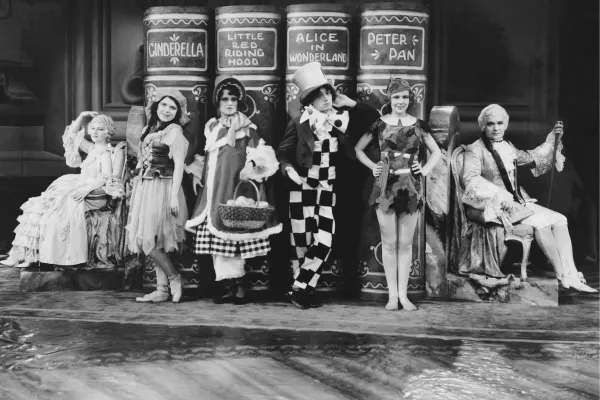
Creating Unforgettable Characters: The Art of Bringing Stories to Life

In the dim light of a Broadway theater, magic happens. Not the kind with smoke and mirrors, but the profound magic of transformation – when an actor becomes so deeply embedded in their character that the audience forgets they're watching a performance.
Directing a production of Little Shop of Horrors I watched in rehearsal one day as my Audrey played by the incomparable Amy Eschman “found the character”. There was this special moment when I was guiding her that she simply became her. It was like there was no differentiation between actor and character.
After thirty years of producing theater and helping creators develop their stories, I've discovered that this same magic is available to anyone telling a story, whether it's on stage, screen, or page.
The Heart of Character
Think about the last character that stayed with you long after the story ended. Chances are, they weren't perfect. They probably weren't even entirely likable. But they were real. They contained contradictions that made them feel deeply human. Like the tough-as-nails business executive who secretly keeps a garden, or the charming social butterfly who goes home to crushing loneliness.
These contradictions aren't random – they're the essence of what makes characters unforgettable. In theater, we often say that a character is born in the space between what they show the world and what they hide from it. This gap between exterior and interior life creates tension, and tension creates interest. In film we require our lead character to have at least 7 flaws.
The Dance of External and Internal Life
Imagine your character as a dancer performing two different dances at once. The first is their external dance – the rhythm they show to the world. It's in their walk, their talk, their habitual gestures. Maybe they're always checking their watch, or perhaps they have a nervous laugh that appears at just the wrong moments. These external patterns tell us who they think they are, or who they want others to think they are.
But underneath, there's another dance happening – their internal rhythm. This is the beat of their fears, their desires, their deeply held beliefs about themselves and the world. Sometimes these two dances align perfectly, but more often, they create a fascinating dissonance.
Finding Your Character's Truth
In my years of directing, I've developed what I call the "Sacred Question" technique. Instead of starting with the obvious questions about a character's background or appearance, we begin with this: "What do they consider sacred?"
This might seem strange at first. After all, many characters aren't obviously spiritual or religious. But that's not what we're looking for. We're searching for what they value above all else. What would they protect at any cost? What do they believe in so deeply that it shapes every decision they make? An actor asks what does the character want. The Sacred Question takes that to the next level.
I once worked with an actor who was struggling to connect with their character – a seemingly cold, calculating corporate lawyer. Everything changed when he discovered what this character held sacred: the memory of their father's white collar crime and the shame it brought their family. Suddenly, every harsh decision, every ruthless move had an emotional core of protection and prevention. The character became not just believable, but deeply human.
The Power of Contradiction
The most memorable characters often emerge from what I call "productive tension" – the space where opposing traits create energy rather than confusion. Think of it like a rubber band pulled taut between two points. The tension itself creates the energy that drives the character forward.
For example, consider a character who's both extremely generous and pathologically untrusting. At first glance, these traits might seem incompatible. But what if their generosity comes from a deep need to prove people wrong about them? Or what if their distrust stems from having their generosity taken advantage of too many times? Suddenly, these contradictions don't weaken the character – they strengthen it.
The Living Character Exercise
One of the most powerful exercises we use in theater can be adapted for any kind of storytelling. We call it "A Day in the Life." Instead of focusing on the big moments in your character's story, spend time imagining their ordinary day. What do they eat for breakfast? Do they make their bed? What do they do when they're alone?
These details might never appear in your actual story, but they create the foundation of authenticity that makes a character feel real. It's often in these small moments that we discover the most revealing aspects of who they are.
The Relationship Mirror
Characters don't exist in isolation. Even the loneliest hermit is defined by their relationship to the world they've rejected. You can discover who a character is by exploring how they change around different people. The same person might be confident with subordinates, insecure with peers, and completely different with family.
These variations aren't inconsistency – they're depth. Each relationship reveals another facet of who they are, like light hitting different sides of a crystal. I mean, don’t you act differently to some degree with different people? We all do.
Bringing It All Together
Creating an unforgettable character isn't about following a formula or checking boxes on a character sheet. It's about finding the humanity – the hopes, fears, contradictions, and sacred beliefs that make them real.
Start with what they hold sacred. Add their contradictions. Explore their ordinary moments. Let them surprise you. Because the most unforgettable characters often end up telling us something about ourselves.
Discovery The Character Practice: A Theater-Meets-Mindfulness Exercise
A powerful exercise I use with storytellers is one that combines theatrical character work with mindful awareness practices. Set aside 20 uninterrupted minutes for this exploration.
The Grounding (2 minutes) Sit comfortably and take three deep belly breaths. Center yourself in the present moment. This isn't about thinking - it's about creating space for your character to emerge.
The Embodiment (5 minutes) Close your eyes. Imagine stepping into your character's body. How do they breathe? Where do they hold tension? What's their natural rhythm? Don't judge or analyze - just notice.
The Sacred Question (5 minutes) From this embodied state, ask your character these questions. Let the answers emerge naturally:
The Movement (3 minutes) Stand up. Let your character move through the space. Are they quick or slow? Do they flow or march? What gesture do they repeat without thinking? Let their body tell you who they are.
The Integration (5 minutes) Return to your seat. Write a brief scene showing your character in an everyday moment - making coffee, waiting for a bus, preparing for bed. Focus on the small details that reveal their inner world.
The goal isn't to figure your character out - it's to discover them. Sometimes the most powerful insights come from what surprises you about them. Let the writing flow from this space.
